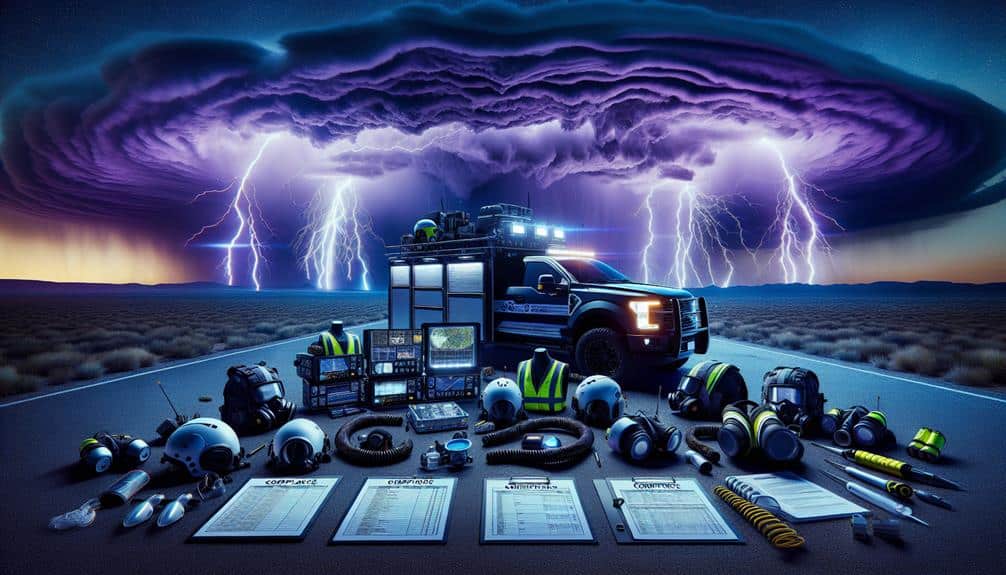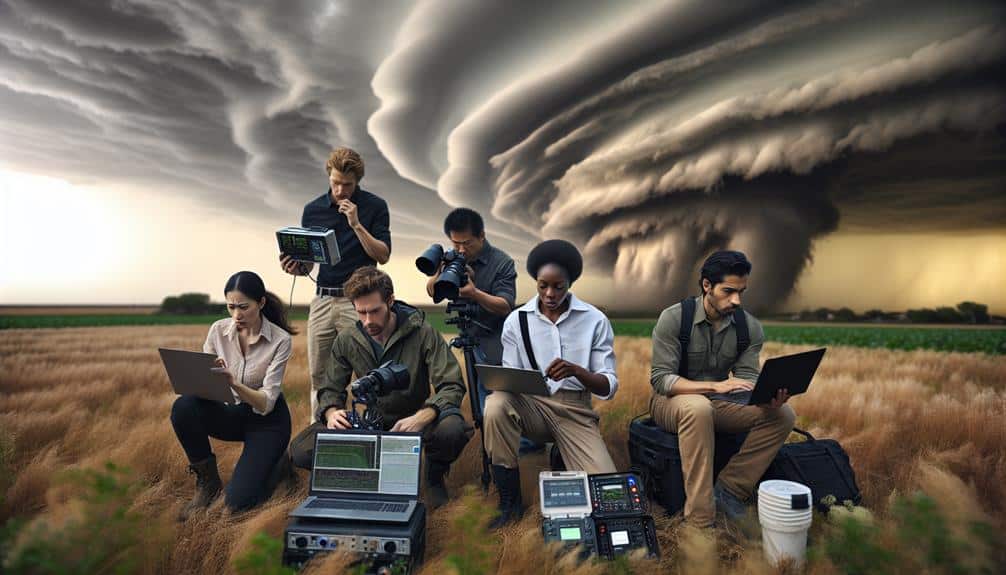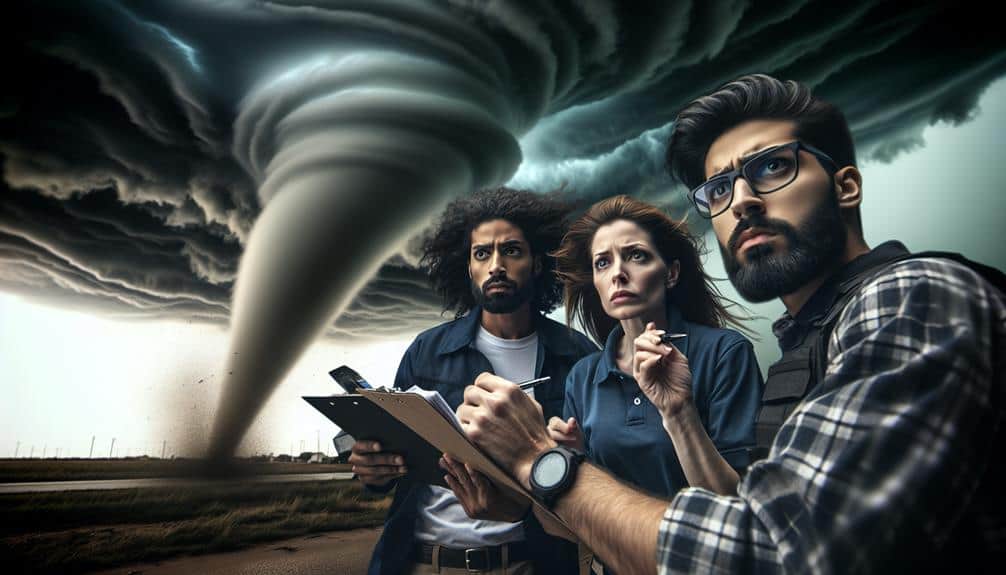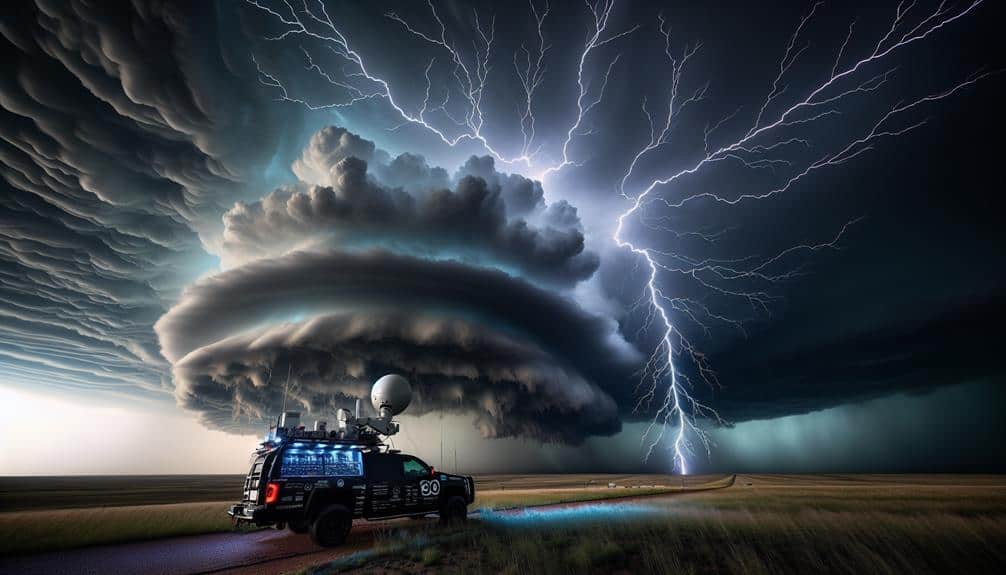In storm chasing technology, we commit to ethical standards by prioritizing data privacy, ensuring informed consent, and adopting eco-friendly practices. We safeguard sensitive information with robust security measures and transparent reporting. By engaging with local communities and respecting natural habitats, we minimize our environmental footprint. Adhering to stringent safety protocols and validating data accuracy through regular audits maintains trust and reliability. Ethical decision-making, community collaboration, and responsible data sharing are cornerstones of our operations. Our dedication to these principles helps us balance the excitement of storm chasing with our ethical responsibilities. Discover how we navigate these challenges effectively.
Key Points
- Prioritize data privacy and obtain explicit user consent before data collection or sharing.
- Implement robust safety standards and conduct regular training and inspections.
- Use eco-friendly vehicles and sustainable practices to minimize environmental impact.
- Engage with local communities for collaboration and incorporate their knowledge.
Data Privacy Concerns
As storm chasers, we must prioritize data privacy to guarantee that personal information collected during our pursuits is protected and used ethically. Every bit of data we gather can be a double-edged sword. While it helps us understand storm patterns and save lives, it also comes with the responsibility to safeguard individuals' privacy. Our audience trusts us with sensitive information, and we can't betray that trust.
User consent is paramount. Before collecting or sharing any data, we must verify that those involved are fully aware and have agreed to it. This includes explaining how their data will be used and stored. It's not just about ticking a box; it's about fostering transparency and respect.
Data security is another critical aspect. We need to implement robust measures to protect the data from breaches or unauthorized access. Encryption, secure servers, and regular audits are essential practices. By doing so, we not only comply with legal standards but also uphold ethical ones.
Ultimately, our goal is to balance the need for valuable meteorological data with the imperative to protect individual privacy. By being conscientious about user consent and data security, we honor both our mission and our ethical obligations.
Informed Consent Protocols
To verify ethical practices, we must establish clear and detailed informed consent protocols before collecting any data. This starts with respecting participant rights and guaranteeing they fully understand what they're agreeing to. We should provide extensive information about the scope of the data collection, how the data will be used, and any potential risks involved.
Ethical considerations are paramount in storm chasing technology. We need to guarantee that participants aren't only aware of the benefits but also the potential consequences of their involvement. This means offering them the autonomy to make an informed decision without any coercion. Transparent communication fosters trust and upholds the integrity of our research.
Informed consent isn't just a formality; it's a fundamental ethical obligation. By prioritizing participant rights, we reinforce our commitment to ethical standards. Participants should always have the freedom to withdraw their consent at any time without any repercussions.
Ultimately, our goal is to advance storm chasing technology responsibly. Through rigorous informed consent protocols, we can protect participant rights and maintain ethical integrity, ensuring that our pursuit of knowledge doesn't infringe on personal freedoms or ethical standards.
Minimizing Environmental Impact
While we prioritize informed consent to uphold ethical standards, we must also focus on minimizing our environmental impact during storm chasing activities. By adopting eco-friendly solutions and sustainable practices, we can guarantee that our efforts to study and understand severe weather phenomena don't come at the expense of the environment we cherish.
First, let's consider eco-friendly vehicle choices. Electric and hybrid vehicles drastically reduce our carbon footprint compared to traditional, gasoline-powered options. Additionally, they allow us to chase storms without contributing to air pollution, aligning our passion with environmental responsibility.
Second, we should utilize sustainable practices in our field operations. For instance, instead of relying on disposable batteries for our equipment, we can use rechargeable batteries. This small change significantly reduces electronic waste and ensures that we're not leaving a trail of pollution in our wake.
Lastly, minimizing habitat disturbance is essential. Respecting natural habitats and avoiding unnecessary off-road driving helps preserve the local fauna and flora. These small, conscientious decisions make a big impact.
Transparency in Reporting
As storm chasers, we must prioritize transparency in reporting to maintain public trust and enhance safety.
Adhering to strict data accuracy standards and verifying our sources guarantees we provide reliable information.
Clear communication channels with both the public and authorities are essential for timely and effective dissemination of storm data.
Data Accuracy Standards
Validating data accuracy in storm chasing technology demands our steadfast commitment to transparency in reporting. We must prioritize accuracy validation and data integrity to maintain public trust and uphold ethical standards. By implementing rigorous verification procedures and quality assurance measures, we can guarantee that the information we provide is both reliable and actionable.
To achieve transparency in reporting, we need to:
- Regularly audit data: Consistent checks on data precision help identify and correct errors early, ensuring that our reports remain trustworthy.
- Utilize redundant systems: By cross-verifying data from multiple sources, we enhance the robustness and credibility of our findings.
- Openly share methodologies: Detailing our data collection and analysis processes fosters trust and allows others to replicate our results, reinforcing the reliability of our reports.
Our dedication to these practices ensures that we're not just chasing storms but also contributing valuable, dependable data that can aid in conservation efforts and disaster preparedness.
Transparency in reporting isn't just a technical requirement; it's an ethical obligation. When we adhere to these standards, we empower our audience with the freedom to make informed decisions based on accurate and verified information.
Source Verification Methods
Verifying our sources thoroughly is vital to maintaining the integrity and trustworthiness of our storm chasing data. As we gather and report information on severe weather events, utilizing advanced technologies like blockchain verification and AI algorithms guarantees that our data is both accurate and transparent.
Blockchain verification allows us to create an immutable record of data transactions, making it easier to trace back and verify the origin of each piece of information. This method not only strengthens our credibility but also provides a clear audit trail that can be independently reviewed.
AI algorithms play an important role in swiftly analyzing massive data sets, identifying inconsistencies, and flagging potential errors. By integrating AI into our source verification process, we can achieve a higher level of precision and reliability. This approach aligns with our ethical commitment to provide truthful and verifiable information, fostering trust within the community.
We understand that our audience values freedom and the ability to make informed decisions. By employing these robust verification methods, we guarantee that the data we share isn't only accurate but also ethically sourced, empowering everyone to act based on reliable information.
Clear Communication Channels
We frequently prioritize maintaining clear communication channels to secure transparency in our reporting of storm chasing data. This commitment guarantees that our observations and findings are accessible and understandable to all. By doing so, we foster a culture of trust and accountability among public engagement and stakeholder involvement.
Our approach revolves around three key practices:
- Real-Time Updates: We provide live updates during storm chasing activities. This immediacy allows the public and stakeholders to receive timely information that can be critical for safety and decision-making.
- Open Data Access: All collected data is made accessible to the public. This transparency allows independent verification and fosters a collaborative environment where various entities can analyze and utilize the data for broader applications.
- Regular Reporting: We publish detailed reports post-chase to offer comprehensive insights into our findings. These reports include methodologies, observations, and implications, ensuring that our entire process is documented and scrutinized.
Safety Standards Compliance

In our storm-chasing endeavors, following safety standards is crucial for both ethical and practical reasons. We need to guarantee our equipment follows rigorous safety protocols and our teams employ effective risk mitigation strategies.
Equipment Safety Protocols
Optimizing our storm chasing equipment while complying with rigorous safety standards is crucial to safeguarding both the environment and human lives. We need to balance our passion for storm chasing with a commitment to ethical practices. This means integrating strong emergency response protocols and meticulous equipment maintenance into our operations.
Proper equipment safety protocols include:
1. Regular Inspections:
We should conduct thorough inspections of all gear before and after each chase. This guarantees that all equipment, from our vehicles to our communication devices, is in peak condition and ready for any emergency response.
2. Compliance with Standards:
Our equipment must adhere to established safety standards set by regulatory bodies. By doing so, we not only safeguard ourselves but also minimize our environmental impact during storm chasing activities.
3. Training and Drills:
We must engage in regular training and emergency response drills. This prepares us for any unforeseen situations, ensuring that we can handle emergencies effectively and ethically.
Risk Mitigation Strategies
Adhering to strict safety standards is paramount in reducing risks and promoting the ethical practice of storm chasing. To achieve this, we need to prioritize stakeholder engagement and regulatory adherence. By actively involving meteorologists, local authorities, and technology developers, we can create thorough safety protocols that protect both storm chasers and the public.
Regulatory adherence ensures that our practices align with legal standards, minimizing liability and promoting trust within the community.
Public awareness is another critical component. Educating the public about our efforts and the inherent risks involved in storm chasing fosters transparency and encourages responsible behavior. When people understand the complexities and safety measures we implement, they're more likely to support our endeavors and respect our boundaries.
Ethical decision making must guide every aspect of our operations. We should always weigh the potential benefits of storm chasing against the possible dangers, making sure that our actions don't endanger lives or property. By following these principles, we not only uphold the integrity of our work but also contribute to the broader goal of advancing scientific understanding while safeguarding the environment and communities we serve.
Responsible Data Sharing
Sharing storm chase data responsibly protects both the environment and the privacy of individuals impacted by severe weather. To guarantee we're acting ethically, we must focus on consent management and data protection. It's vital that we gather and share data with transparency and respect for those who might be affected. By doing so, we can maintain public trust and support the greater good.
First, we should establish clear protocols for consent management. This includes:
- Obtaining explicit approval from individuals before collecting any personal data.
- Clarifying the purpose of data collection and how the information will be used.
- Offering alternatives for individuals to opt-out if they choose not to share their data.
Second, data protection measures are essential. We need robust security systems to safeguard sensitive information against breaches and misuse. Encryption, secure storage, and regular audits are non-negotiable to guarantee the integrity of the data we handle.
Community Collaboration

To enhance our storm chasing initiatives, we must actively engage with local communities, leveraging their knowledge and fostering trust through transparent and ethical collaboration. Public engagement is key to our success. By involving community members from the outset, we gain invaluable insights into local weather patterns and historical storm data. This grassroots knowledge complements our advanced technology integration, creating a holistic approach to storm tracking and forecasting.
Research collaboration with local institutions is another cornerstone of our efforts. By partnering with universities and local meteorological stations, we pool resources and expertise, ensuring that our storm chasing technology is both cutting-edge and community-focused. This kind of cooperation not only advances our scientific understanding but also strengthens community ties.
Community involvement is essential for maintaining ethical standards. We must be clear about our objectives and methods, ensuring that all stakeholders understand how data will be used and shared. Transparency builds trust, making it easier for communities to support our initiatives and even participate in them.
Frequently Asked Questions
How Can Storm Chasers Maintain Objectivity in Their Data Collection?
To uphold objectivity in our data collection, we must prioritize data integrity and impartial reporting. By adhering to ethical considerations and focusing on conservation, we guarantee our findings are reliable and contribute to the greater good.
What Qualifications Should Ethical Storm Chasers Possess?
We all know storm chasing's just a walk in the park, right? Ethical storm chasers should possess a solid understanding of ethical behavior, adhere to professional standards, and commit to conservation-focused actions that respect both nature and human safety.
Are There Specific Guidelines for Interacting With Local Wildlife During Storm Chases?
We should follow specific guidelines for interacting with local wildlife during storm chases. By practicing respectful observation and prioritizing wildlife preservation, we guarantee that our activities don't harm the natural inhabitants of the areas we explore.
How Do Storm Chasers Ensure Their Presence Doesn't Disrupt Emergency Services?
We coordinate with emergency response teams to guarantee our storm chasing activities don't interfere. Through active community engagement, we prioritize ethical considerations, respecting local needs while preserving our freedom to document severe weather responsibly.
What Measures Are in Place to Prevent the Exploitation of Vulnerable Communities?
We safeguard vulnerable communities aren't exploited by prioritizing community engagement and maintaining data transparency. By collaborating with local leaders and sharing data openly, we foster trust and protect community interests while chasing responsibly and ethically.


